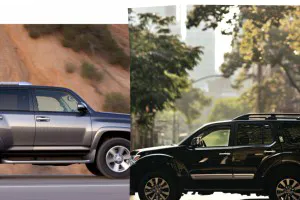The GMC Yukon has been a strong contender in the premium full-sized SUV category for almost three decades. It’s a logical choice for someone who wants something slightly more upscale than the Chevrolet Tahoe but thinks the Cadillac Escalade is too over the top. At the same time, the Yukon competes with the Ford Expedition, Jeep Wagoneer, Nissan Armada, and Toyota Sequoia.
The GMC Yukon’s long history means an abundant selection of used examples. There are good years and bad years. We’ll detail these differences, so you’ll know what to buy and avoid. This assessment will also give you insights on what to expect if you already own a GMC Yukon.
Our recommendations result from a thorough review of critical data. This information comes from many sources, including GMC Yukon models with an installed FIXD sensor (which gives us the FIXD Reliability Score). In addition, a FIXD survey of Yukon owners, which produces the Owner Reliability Score, tracks thoughts about reliability, particular trouble areas, repair expenses, and overall ownership experiences.
The FIXD Reliability and Owner Reliability Scores are combined with public data about crash tests, fuel economy, and resale value to produce these model year rankings.
Review this chart for an overview of the best and worst GMC Yukon model years, and keep reading to learn the details.
| Best Years | Why? | Worst Years | Why? |
| 2017-2019 |
Top engine reliability and owner reliability scores, low annual upkeep expenses |
2021 |
First year of the fifth generation, a large number of recalls |
| 2013-2014 |
Good engine reliability and owner reliability scores, respectable safety ratings |
2015-2016 |
First year of the fourth generation (2015), increased chance of expensive engine repairs |
| 2009 |
Strong owner reliability scores, low likelihood of costly engine and transmission repairs |
2007-2008, 2010-2012 |
First year of the third generation (2007), higher likelihood of expensive engine and transmission repairs |
| 2005 |
Above-average owner reliability scores, lower chance of engine and transmission repairs |
2001-2004, 2006 |
Low engine reliability and safety scores, a high chance of expensive engine repairs |
GMC Yukon Engine Reliability Score, Safety Ratings & MPG Year by Year
Several factors help us identify the best and worst GMC Yukon model years.
- Engine reliability (the FIXD Reliability Score) and the Owner Reliability Score
- Crash test ratings
- Fuel economy
- Annual upkeep costs compared to market value
We’ve explained below how these elements come into play.
If you’re in the market for a car, take a look at our article on the USA’s most reliable and cheapest to repair vehicles in the U.S. Don’t get stuck with a lemon; use our data to help you shop.
Engine Reliability Score – Over The Years
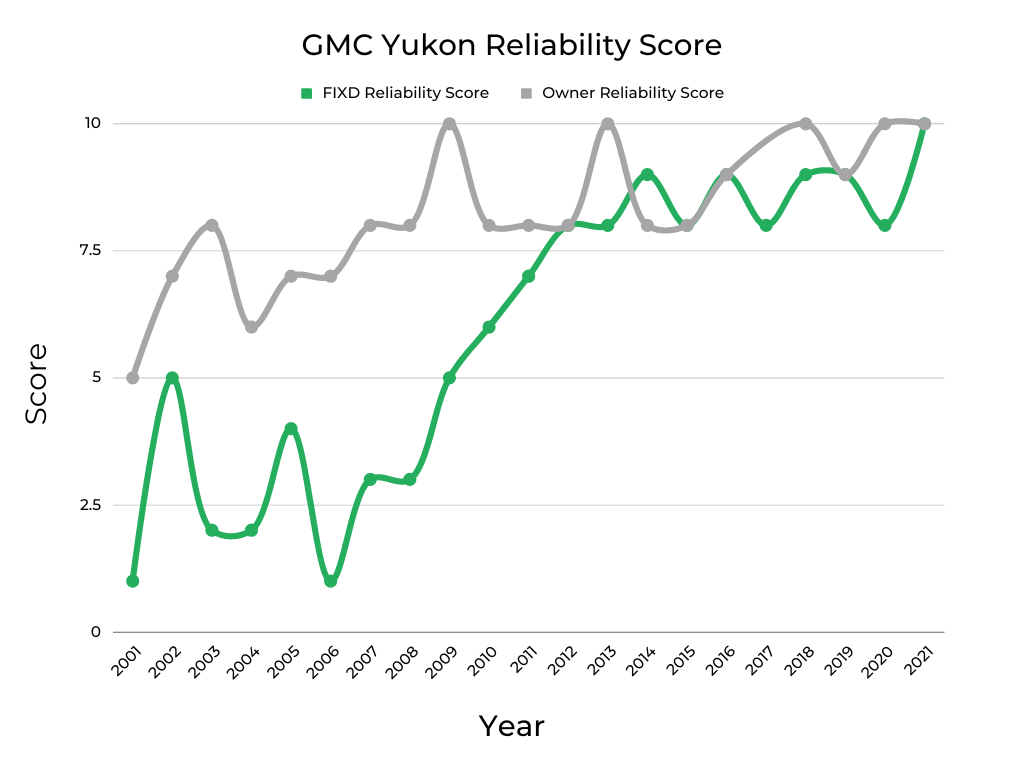
The graph shows two aspects of the engine that we track:
- FIXD Reliability Score (green): This indicator is based on the number of check engine lights that occur with GMC Yukons with an installed FIXD sensor.
- Owner Reliability Score (gray): This ranking is based on an owner’s perceived reliability for their GMC Yukon and how usable their car is for trips of varying lengths. For instance, a vehicle that can only drive basic point A to point B routes scores the lowest. However, a Yukon suitable for longer travels (including extended road trips) ranks higher.
Both scores reflect 10 as the highest and 1 as the lowest; 5 is the average.
In the case of the GMC Yukon, you’ll see that both rankings seldom match up for each model year. However, these scales get much closer starting with the 2010 Yukon. That’s a strong indicator that newer Yukons have more reliable engines. Yet, there are some exceptions, which we’ll go over later. Engine reliability is essential but not the only thing to consider.
It’s also logical to assume that older Yukons are more trouble-prone under the hood. After all, some of these vehicles are more than two decades old. And as a group, owner surveys reveal that 2001-2009 Yukons have an average of 199,000 miles.
That’s a lot of usage, but owners of these older Yukon still believe their SUVs are ready for more than local errands. These thoughts don’t validate engine reliability (one way or another) but simply acknowledge that check engine lights are a fact of life for those who own an older vehicle.
Review the GMC Check Engine Light article to learn about the most common reasons for a check engine light to come on in a Yukon and other GMC vehicles.
NHTSA Safety Score – Over The Years
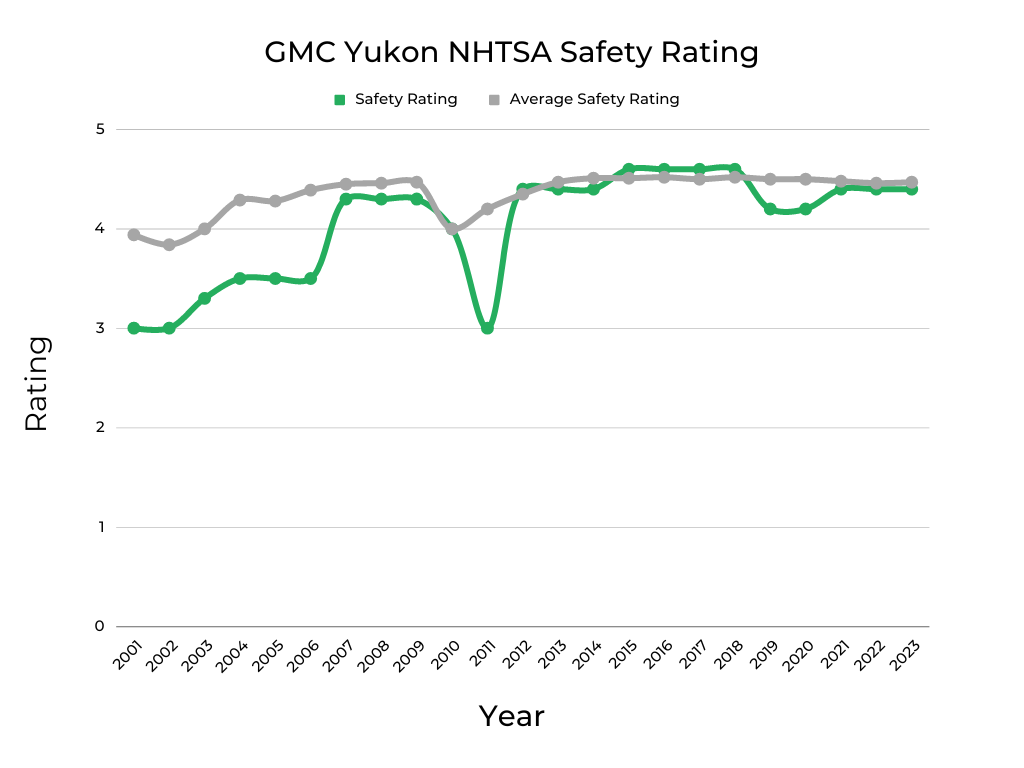
Safety plays a significant role in determining which GMC Yukons get a best-year thumbs up. Often, these three-row behemoths are used for transporting more than the driver or for extended driving. In fact, 24% of owners use their Yukons primarily as family vehicles, while another 46% rely on these SUVs for traveling and commuting.
Not only is a 3.0 (out of 5) score in the National Highway Transportation Safety Administration (NHTSA) crash testing bad, but it’s well below the average 4.0 of this vehicle category. For instance, the 3.0 ranking for the 2001-2002 is particularly dreadful. The Yukon gets slightly better with a 3.3 rating for the 2003 model and shows additional improvement with a 3.5 score for the 2004-2006 editions.
There was a substantial drop in the Yukon’s crash test score for 2011. However, this can be attributed to revised NHTSA testing procedures. The GMC Yukon regained parity with its competitors by the following year.
Strong safety scores play a significant role in keeping vehicle occupants safe, and insurance costs low.
If you live in one of the states listed below, we can show you the cheapest vehicles to insure in yours.
What Used Cars Are the Cheapest To Insure In:
| What Used Cars Are the Cheapest To Insure In: |
| Ohio |
| North Carolina |
| Michigan |
| Georgia |
| Texas |
| New York |
| Illinois |
| Pennsylvania |
| California |
MPG – Over The Years

The conversation about fuel economy and the GMC Yukon is brief; it’s not even close to being a gas sipper. That said, a few miles per gallon can make a difference to those that drive a lot. For someone who travels 15,000 miles per year, a Yukon that gets 16 MPG will cost $779 less annually to fill up than a model that gets 13 MPG (based on gas at $3.60 per gallon).
GMC did offer a hybrid version of the Yukon from 2008-2013. However, this was a marketing effort to promote a large SUV that offered 20 MPG fuel economy. Few people bought these vehicles as the extra cost didn’t outweigh the higher price tag or maintenance concerns.
Introducing the third-generation Yukon for the 2007 model year helped this GMC hit 16 MPG and get closer to competitors. Likewise, the release of the fourth-generation edition in 2015 allowed the Yukon to improve by stretching fuel economy an additional 1-2 MPG.
The GMC Yukon bests or holds its own against the Ford Expedition and Toyota Sequoia for fuel economy. However, Ford catches up due to a twin-turbocharged V6 replacing the Expedition’s V8 for the 2015 model year.
| GMC Yukon | Ford Expedition | Toyota Sequoia | |
| 2007 | 16 MPG | 15 MPG | 15 MPG |
| 2016 | 18 MPG | 17 MPG | 15 MPG |
| 2021 | 17 MPG | 19 MPG | 15 MPG |
Current Market Value of All GMC Yukon Years & Cost Per Year to Repair and Maintain Each
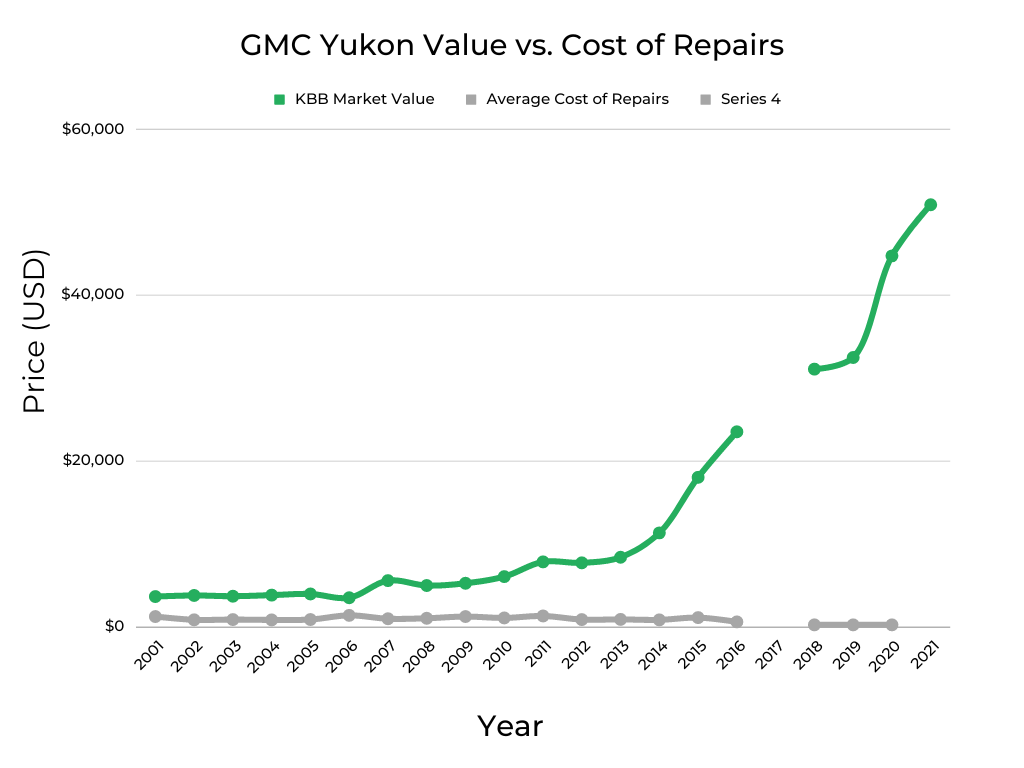
Keeping an eye on annual repair and maintenance expenses is vital because high upkeep costs can negatively impact resale value. According to owner surveys, you can see this with the 2006 Yukon, which costs an average of $1,393 to maintain each year. That makes it among the most expensive 21st-century Yukons to keep on the road. And the dip in resale value takes a predictable decline.
This is further evidenced by the 2006 Yukons in our survey having fewer average miles (160,000) than the adjacent model years (2005 and 2007), which show normal valuations and higher mileage (210,000 and 190,000, respectively).
The 2008 and 2009 Yukons are also expensive to repair and maintain ($1,042 and $1,250, respectively), which likely accounts for the dip in market value for these model years.
Overall, owning a Yukon isn’t cheap. On average, owners shell out $971 annually for repair and maintenance costs. Only a handful of Yukon model years have upkeep costs substantially below this.
The 2016 Yukon costs $607 in this area. Newer Yukons (2018-2020) cost only $250 per year to keep running, but these outlays are likely to increase as brake pads and tires need replacing.
The absence of the 2017 model year from the graph stems from insufficient mileage information from owner surveys. We estimate the 2017 Yukon to have an average value of $28,155, based on 72,000 miles of use.
Here’s an overview of yearly GMC Yukon repair and maintenance expenses by generation.
| GMC Yukon Generation | Years | Average Annual Upkeep |
| Second | 2001-2006* | $1,020 |
| Third | 2007-2014 | $1.040 |
| Fourth | 2015-2020 | $496** |
| Fifth | 2021-2023^ | $2,500^^ |
* The second generation entered production for the 2000 model year
^ The fifth generation is still in production as of May 2023
** Excludes 2017 model year (data unavailable)
^^ Excludes 2022-2023 model years (data unavailable)
The above-average annual upkeep costs for the second and third generations of the GMC Yukon are unsurprising. Brake pads and tires need a periodic replacement; pricey components like the catalytic converter can go bad.
There’s a lot to like about most years of the fourth-generation Yukon (more details later on in the article). At the same time, the $2,500 annual maintenance and repair expenses for the 2021 Yukon are eye-opening. One explanation for this anomaly is repairs that aren’t covered by warranty. If warranty coverage has expired or if the issue isn’t related to workmanship or component failure – the repair is not typically covered.
If you’d like to learn about this vehicle’s past depreciation rate & our projected depreciation rate based on that, check out: GMC Yukon | Depreciation Rate & Curve Graphed.
When shopping for a used GMC Yukon, it’s important to keep in mind that not all vehicles are cared for equally. To protect yourself from lemons, take along a FIXD Sensor on your test drive. FIXD connects to a free app on your smartphone to tell you more about the vehicle you’re checking out, including check engine lights and other hidden issues that the owner or dealership may be attempting to hide. Click here to learn more and get FIXD for only $19.99 (regular price $59)!
Important Features Timeline

1996: A two-door, rear-wheel-drive Yukon joins the lineup
1997: 4WD trims get dual airbags and speed-sensitive steering
1998: The two-door version is dropped
1999: The upscale Denali trim is added to the Yukon range
2000: First year of the 2nd-generation Yukon with new engines and an improved chassis
2001: The Denali gets a new engine and standard AWD
2002: No major changes
2003: Upgrades to the brakes and safety systems; satellite radio is a new option
2004: A tire pressure management system is added as standard equipment
2005: Touchscreen navigation is optional; an overhead liftgate is standard
2006: Steering wheel-mounted audio controls and stability control are standard
2007: The all-new 3rd-generation Yukon appears
2008: A hybrid V8 engine option is introduced
2009: A 3rd-row seat is standard; a new 6.2-liter V8 debuts as an option
2010: Trim lineup is simplified to SLE, SLT, Hybrid, and Denali/Denali Hybrid
2011: No major changes
2012: Upper Yukon trims get a standard heated steering wheel
2013: No major changes
2014: Last year of the third generation, the base SLE gets a remote start and other upgrades
2015: The 4th-generation Yukon launches with new looks and more power
2016: An improved infotainment touchscreen and Apple CarPlay get added
2017: Low-speed automatic emergency braking is added as standard equipment
2018: The Yukon Denali gets a ten-speed automatic transmission
2019: No major changes for the 2019 Yukon
2020: Last year of the 4th generation Yukon; no major changes
2021: The redesigned 5th-generation GMC Yukon debuts
Best Years of the GMC Yukon
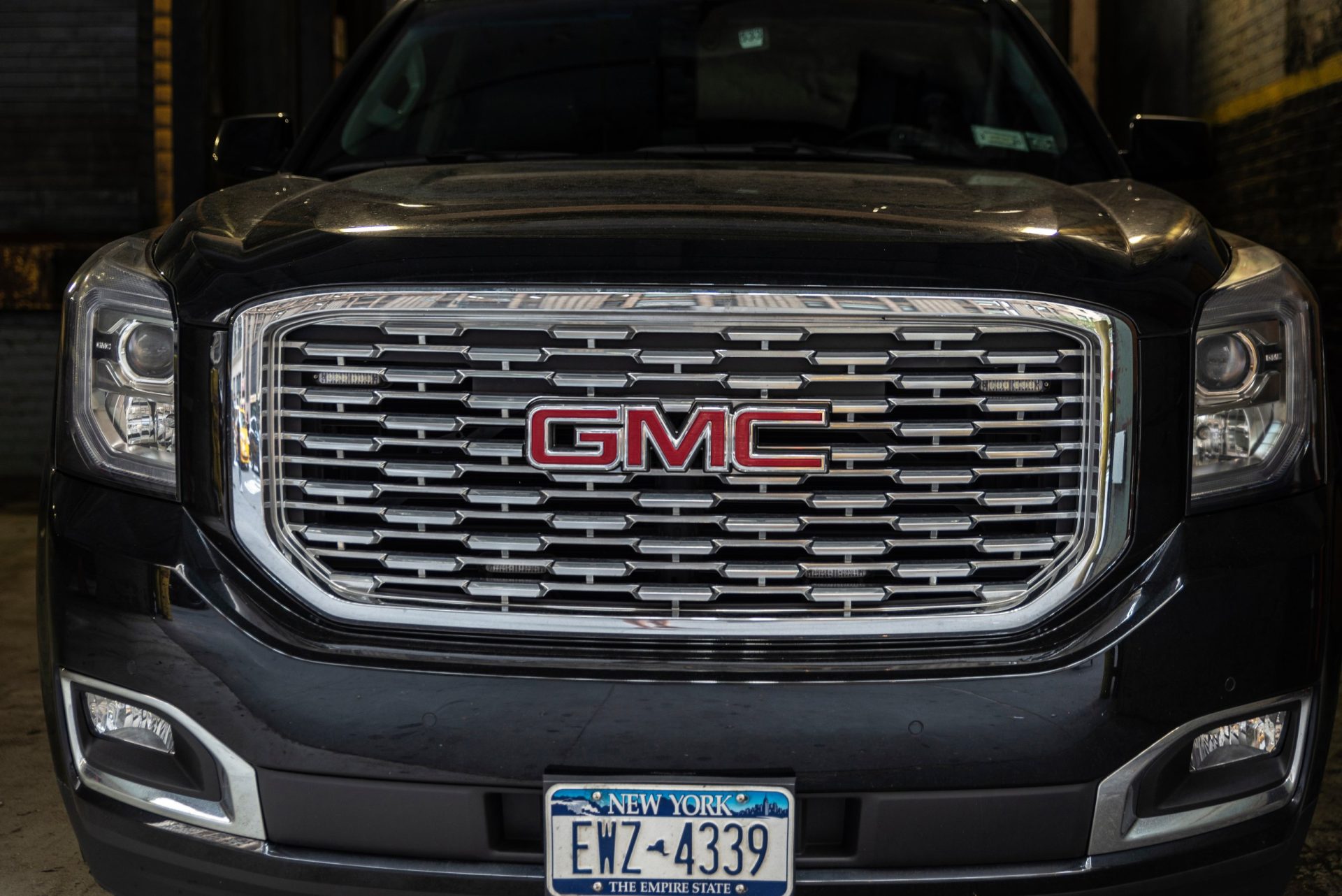
FIXD Reliability Scores, Owner Reliability Scores, NHTSA crash test rankings, and EPA fuel economy determine our picks for the GMC Yukon model years. These choices also consider common diagnostic trouble codes (DTCs) and NHTSA recall information.
2017-2020 GMC Yukon
FIXD Reliability Score: 8-9/10
Owner Reliability Score: 9-10/10
KBB Value: $28,155-$44,734
Fuel Economy: 17-18 MPG
Average Annual Maintenance/Repair: $250
Average Likelihood of a $500+ Repair in 2022: 100%
Safety Rating: 4.2-4.6/5
Unsurprisingly, newer (but not the latest) Yukons appear on the best-year list. This isn’t just because of age (or lack of); the data backs this up. The 2017-2020 model years enjoy high FIXD Reliability and Owner Reliability Score rankings.
In particular, the 2018 Yukon is our sweet spot pick, as it offers an excellent balance of reliability and value. Plus, it has better crash test scores and estimated fuel economy than the 2019-2020 editions (but those are still very good). At retail, expect to pay $35,000 to $45,000 for a decent 2018 Yukon, depending on condition, mileage, and equipment. The KBB Value amount refers to less-expensive, private-party transactions.
Overall, it’s hard to find fault with any Yukons in this model-year grouping. Careful car shopping might uncover examples with some remaining factory warranty (bumper-to-bumper coverage for 3 years or 36,000 miles or powertrain coverage for 5 years or 60,000 miles). GMC also has a certified pre-owned (CPO) program that adds 6 months or 6,000 miles of bumper-to-bumper coverage to any existing original warranty.
There is a 100% chance of these Yukons needing expensive repairs ($500 or more), but that’s not as scary as it sounds (this is normal for an SUV). As a group, the 2018-2020 model years have an average of just over 58,000 miles. That means these costs likely involve tires and brakes, which wear down with use. Otherwise, repair and maintenance expenses are very low at $250 annually.
In addition, owner surveys showed zero major repairs during the past year for the engine, transmission, or other significant systems for the 2018-2020 Yukon. There is no data in this area for the 2017 Yukon.
Interestingly, there aren’t many DTC codes to worry about with this group of Yukons, even though some of these SUVs have been in service for a half-decade or more. Of these, error code P0700 is the most common, which involves the transmission control module. If service for this problem falls outside of warranty, repairs can cost $2,528 to $3,045.
Fortunately, only about two dozen instances of code P0700 appear in 2017-2020 Yukons with the FIXD sensor. That’s a very low number and should comfort buyers and owners.
A similar number of P0300 codes are also occurring in these Yukons, indicating a potentially serious engine misfire. Repairs can be minor, such as replacing the spark plugs (cost: $58-$167), or quite pricey, like if the catalytic converter needs replacing (cost: $1,720 to $2,400).
Lastly, code P050D (a problem with the #4 fuel injector) appears in the data, but most of this has happened with the 2017 Yukon. And then only 19 instances were recorded. Non-warranty repairs for this issue usually run $301-$463.
Among the most favorite features, an average of 35% of owners like the Yukon’s great driver visibility. A separate 35% cited an abundance of interior storage as their preferred feature. Curiously, 100% of the 2019-2020 Yukon owners felt their SUVs didn’t have enough interior storage. Our take on this storage feedback is that it refers to the front-row area for stowing cell phones and other personal items. As one of the largest SUVs on the road, the Yukon usually doesn’t come up short for cargo storage.
These Yukons are used for a variety of purposes. An average of 47% of owners use their SUVs for “lots of driving,” like traveling and commuting. Another 23% rely on the Yukon for family transportation, while 20% use this GMC for outdoor and off-road journeys.
The 2017-2018 Yukons slightly edge out the 2019-2020 editions in two areas:
| 2017-2018 | 2019-2020 | |
| NHTSA Crash Tests (out of 5.0) | 4.6 | 4.2 |
| EPA Estimated Fuel Economy | 18 MPG | 17 MPG |
But the differences are minor. So choosing a particular model year from this group comes down to price and what’s available.
What’s also noteworthy about the 2017-2020 Yukons is how few recalls there are. Some model years and variants had zero, while others had only three. This group (2017, 2018, 2019, and 2020) had the lowest number of recalls among any 21st-century Yukon.
2013-2014 GMC Yukon
FIXD Reliability Score: 8-9/10
Owner Reliability Score: 8-10/10
KBB Value: $8,397-$11,338
Fuel Economy: 15-16 MPG
Average Annual Maintenance/Repair: $850-$906
Average Likelihood of a $500+ Repair in 2022: 78%-83%
Safety Rating: 4.4/5
For those not wanting to spend $30,000 or more on a used GMC Yukon, the next-best choices are the 2013-2014 model years. Buying one of these editions will set you back $12,000 to $25,000.
Despite being a decade old and having an average of 173,000 miles, these Yukons are rated a well above-average 8 or 9 for a FIXD Reliability Score. And the Owner Reliability Scores (8 for 2013, 10 for 2014) are also noteworthy.
Annual costs for maintenance repair ($906 for 2013, $850 for 2014) are almost spot on, with an overall average of $971 for all 21st-century Yukons. That’s impressive for a vehicle with ten years of use and high mileage.
Yet it’s important to understand that these Yukon model years aren’t perfect. In particular, the 2013 edition has a 17.3% chance of an expensive engine repair and an 8.7% of costly transmission work. The 2014 Yukon also has an elevated likelihood of pricey engine (13.8%) and transmission (11.9%) repairs. This information comes from surveyed owners and their experiences during the past year.
The most common DTC codes for the 2013-2014 Yukon are P015D and P015B, which indicate a delayed oxygen sensor response (part of the emissions control system). The issue can also be related to a faulty powertrain control module (PCM). The most straightforward fix involves repairing an exhaust leak (cost: $150-$200) or replacing the oxygen sensor (cost: $200-$300). However, things can get more elaborate and expensive, such as a new catalytic converter or a replacement PCM (cost: $2,049-$2,567).
Another known code to occur with the 2013-2014 GMC Yukon is P0523, an engine oil pressure sensor (switch “A” circuit high). Fortunately, the repairs for this issue are inexpensive at $91-$151.
Owners of 2013-2014 Yukons like the great driver visibility (21%) and the easy-to-use entertainment system (20%) as the most favored features. A third of the 2014 Yukon owners felt that the driver’s visibility was poor. We don’t know the specifics, but this likely involves rear visibility, which is challenging on any three-row SUV.
This Yukon grouping sees usage similar to newer counterparts. 38% of owners use these SUVs for traveling and commuting, while another 28% rely on their Yukons for family duty. Still, an additional 23% engage in “sport/fast driving” with these GMCs.
Another factor favoring the 2013-2014 Yukon is the low number of recalls. The 2013 edition has only four recalls on record, while the 2014 Yukon has three. Meanwhile, solid NHTSA crash test scores (4.4 out of 5.0) offer confidence and security for everyone in the cabin.
2009 GMC Yukon
FIXD Reliability Score: 5/10
Owner Reliability Score: 10/10
KBB Value: $5,262
Fuel Economy: 16 MPG
Average Annual Maintenance/Repair: $1,250
Average Likelihood of a $500+ Repair in 2022: 100%
Safety Rating: 4.3/5
A FIXD Reliability Score of 5 (out of 10) is average, but the 2009 Yukon does better than average in many other categories. Specifically, a perfect 10 for the Owner Reliability Score is remarkable for a vehicle with an average of 175,000 miles. It shows you that owners love these SUVs, even with check engine lights that occur.
Another positive for the 2009 Yukon is zero reports of expensive engine or transmission repairs during the past year. That’s impressive for an almost 15-year-old vehicle. Yes, there is a 100% likelihood of work requiring a $500 or greater expense, but at least it doesn’t involve the engine or gearbox (transmission). In fact, the data shows there’s a 50% chance such work focuses on the Yukon’s fuel system.
At $1,250, yearly upkeep expenses are above average, but that’s the price you’ll pay for owning an older vehicle. And you can expect to pay $8,000-$12,000 for a 2009 Yukon, depending on trim, condition, and mileage.
And as another reminder that older vehicles are seldom trouble-free, the 2009 Yukon is prone to a few frequent DTC codes. Among them are P0420 and P0430, which indicate a bad catalytic converter. These codes aren’t unusual with a vehicle that’s older and well-driven.
As mentioned, catalytic converters aren’t cheap to replace but wear out over time. And this component failure can happen sooner thanks to cheap gas and poor maintenance. Be sure that a pre-purchase inspection includes a thorough look at the emissions system if you’re considering buying a 2009 Yukon.
And speaking of emissions, P0455 is another common error code with this Yukon. It involves the evaporative emission control (EVAP) system. Repairs could be basic, such as a replacement gas cap (cost: $20-$60) or a new valve or EVAP line (cost: $50-$100). However, expect to pay $200-$600 if a new EVAP canister is needed.
Prospective buyers of a 2009 Yukon can take comfort in knowing that 17% of owners are confident their GMC will take them past 200,000 miles (or already have). An equal number of owners said they liked the 2009 Yukon’s great driver visibility, excellent sound system, and comfortable seats.
A 4.3 out of 5.0 in government crash tests isn’t the best for a Yukon (that’s a 4.6), but it’s pretty close. The 2009 had five recalls meaning this Yukon left the factory with fewer issues than many other model years.
For someone on a tight budget and needing a large three-row SUV, it’s hard to look past the 2009 Yukon.
2005 GMC Yukon
FIXD Reliability Score: 4/10
Owner Reliability Score: 7/10
KBB Value: $3,973
Fuel Economy: 15 MPG
Average Annual Maintenance/Repair: $889
Average Likelihood of a $500+ Repair in 2022: 89%
Safety Rating: 3.5/5
We include the 2005 Yukon on our best listing because it’s the one to buy if you’ve only got $5,000 to $8,000. It’s far from flawless but is tops among the second-generation Yukon models. It’s fair to call the 2005 model year the least-best Yukon.
Typically, a FIXD Reliability Score of 4 would be a reason to cross a vehicle off this best-year list. However, this is offset somewhat by an Owner Reliability Score of 7. There are other positives to consider, yet these are relative to other second-generation Yukons (2001-2006).
A NHTSA crash test score of 3.5 is subpar, but it’s among the best for this era Yukon. Meanwhile, the 2002 Yukon actually had a slightly better FIXD Reliability Score (5), but its 3.0 crash test ranking disqualified it. Our thinking is that it’s better to prioritize safety over reliability.
The 2009 Yukon has an average annual repair and maintenance expense of $889, slightly below the $971 average for the 2001-2021 model years. However, the wallet could take another hit as 89% of 2005 Yukon owners reported a repair costing more than $500 in the last year.
Of these repairs, 10% involved the engine, and 8% affected the transmission. Meaning the vast majority of costly problems didn’t apply to the most expensive components; that’s good news.
And five recalls for the 2005 Yukon are on the lower side of things for the second generation.
Of course, DTC error codes are expected with older vehicles, which is no different from the 2005 Yukon. Problems with the mass airflow (MAF) sensor are common. Code P0171 indicates a MAF sensor malfunction, which could be fixed by a cleaning (cost: $20-$100) or a vacuum leak repair (cost: $100-$200). In some cases, a new MAF sensor may be required (cost: $230-$300).
A related code, P0101, warns of a MAF circuit problem. This can be corrected with a new air filter. Although more significant repairs may require a new MAF sensor or a catalytic converter.
Another typical code for the 2005 Yukon is P0332, a faulty knock sensor. With luck, repairs only cost $14-$66 to replace the knock sensor harness. However, more expensive work could require a new knock sensor (cost: $297-$381) or a new temperature sensor (cost: $392-$427).
The 2005 Yukon certainly isn’t an ideal model year, but it’s far better than other second-generation examples.
The Worst Years of the GMC Yukon
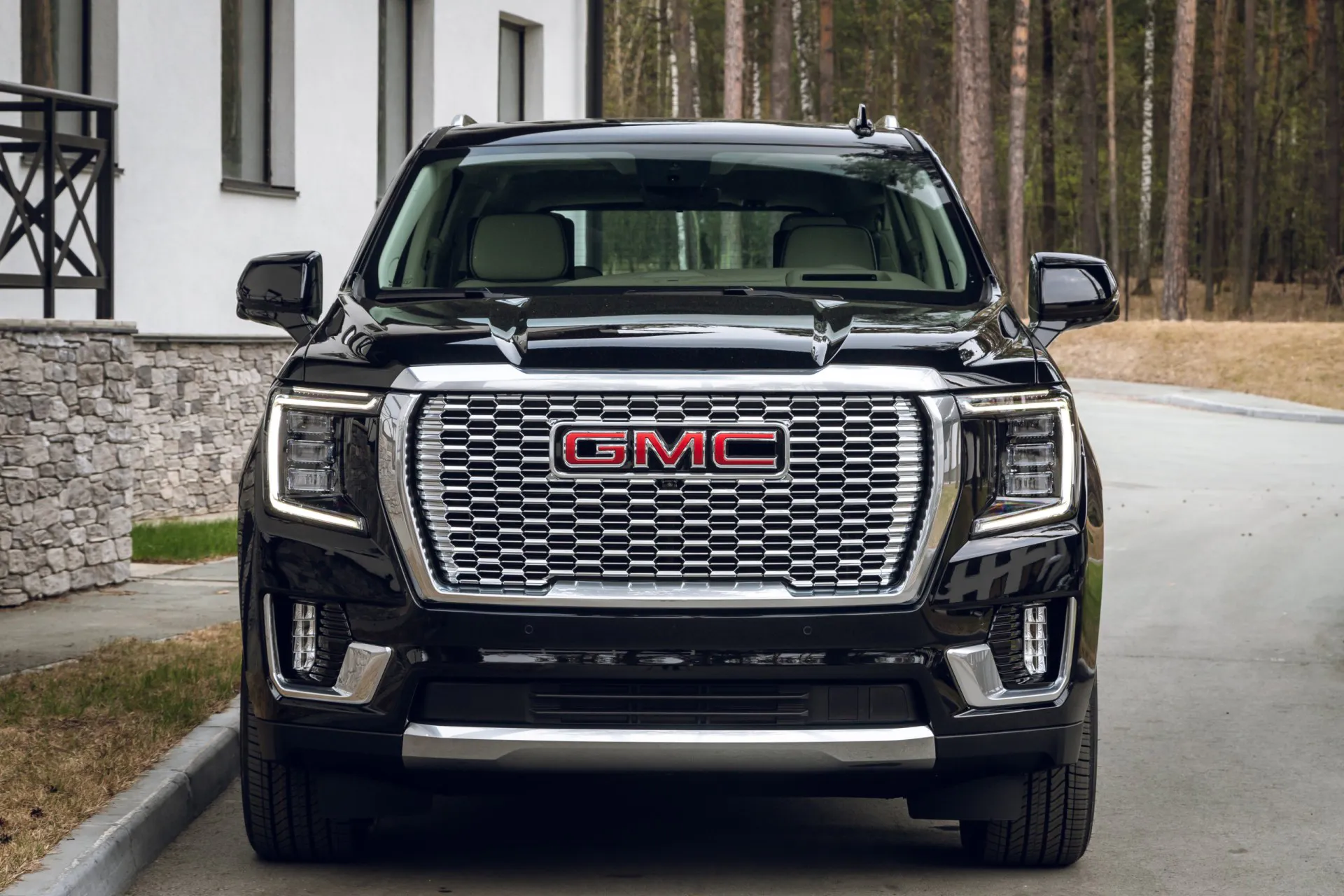
The GMC Yukon’s bad years outweigh the good ones. So, reviewing this list of model years to avoid is crucial. These “don’t buy” recommendations are based on analyzing the FIXD Reliability Score, Owner Reliability Score, and other key measures.
2021 GMC Yukon
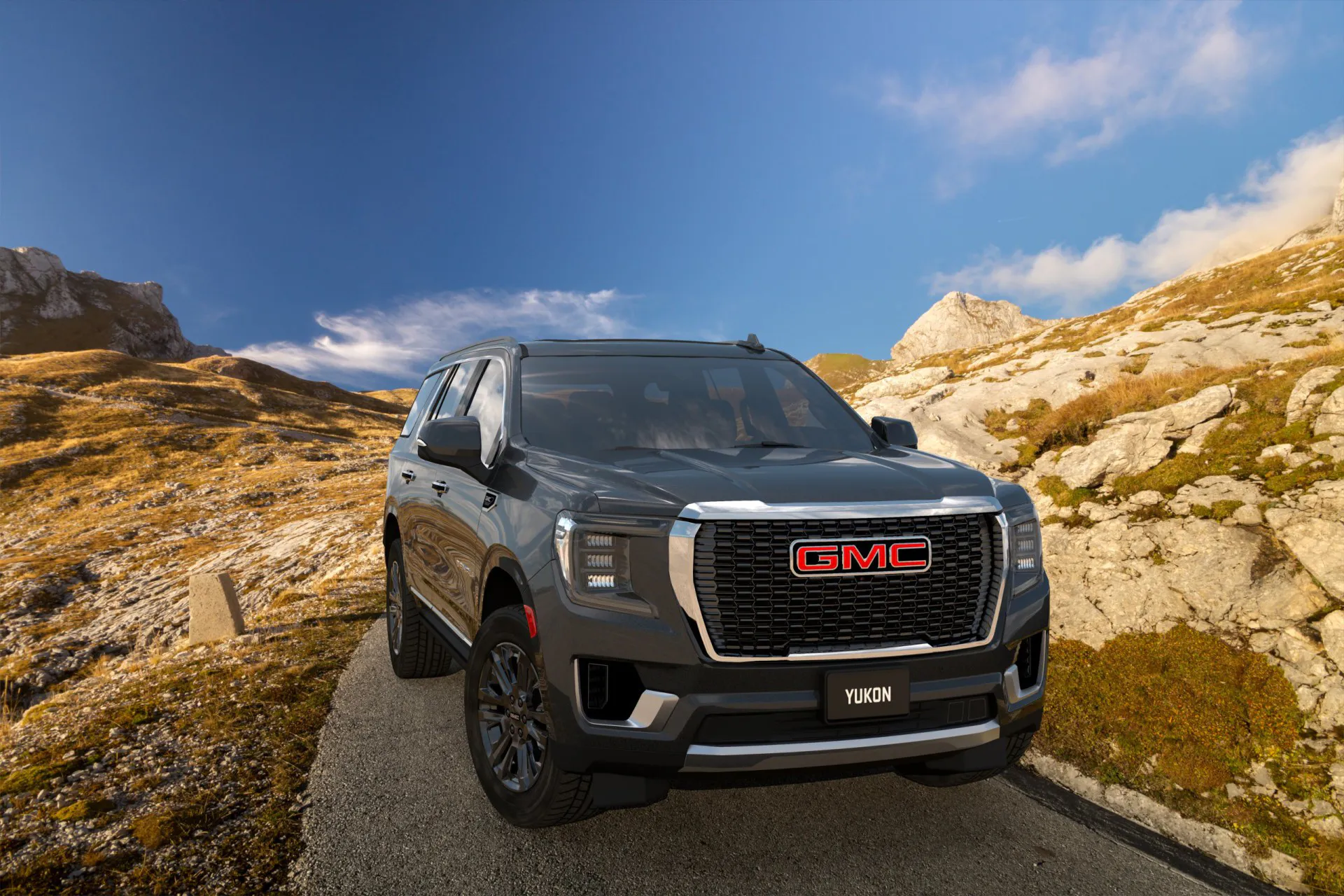
FIXD Reliability Score: 10/10
Owner Reliability Score: 10/10
KBB Value: $50,895
Fuel Economy: 17 MPG
Average Annual Maintenance/Repair: $2,500
Average Likelihood of a $500+ Repair in 2022: 100%
Safety Rating: 4.4/5
You’ll see a recurring theme in our “don’t buy advice, avoid the first year or two of an all-new vehicle. This may sound like a broken record if you’ve read our other “Best & Worst Years” reviews, like with the Chevrolet Tahoe. But a closer look at the 2021 GMC Yukon, the first year of the fifth generation, proves why.
To begin with, the 2021 GMC Yukon has 11 recalls indicating multiple failures in engineering and manufacturing. And that’s only the problems that GMC acknowledges. Who knows what other issues are waiting for unsuspecting owners?
Another reason the 2021 Yukon is on our worst list is that there’s too little owner survey data to confirm a positive recommendation. In these situations, it’s better for a buyer to wait than risk large sums of money on an unproven vehicle.
Also, people tend to buy the FIXD app for newer cars when they’re experiencing problems. That’s likely what’s happening here; it will just take some time to extract the details of why.
The 2021 Yukon also has its shares of DTC error codes. Although, admittingly, these count in the dozens (not hundreds or thousands) at this point. DTC P049B indicates an error with the auxiliary emissions system, and P14D9 signals a problem with engine calibration and software. Code P11D5 warns of issues with nitrogen oxide sensors (part of the Yukon’s pollution controls). Fixes typically involve software reprogramming, but that still means time at the dealer.
Although a practically new vehicle can be appealing, wise buyers shouldn’t spend over $50,000 for an SUV with unpredictable reliability.
About the 2022 and 2023 GMC Yukon: At this point, there’s little data about these latest Yukons. As a result, we’ll hold off on making any recommendations about these GMCs.
2015-2016 GMC Yukon
FIXD Reliability Score: 8-9/10
Owner Reliability Score: 9/10
KBB Value: $18,306-$23,524
Fuel Economy: 17-18 MPG
Average Annual Maintenance/Repair: $607-$1,125
Average Likelihood of a $500+ Repair in 2022: 83%
Safety Rating: 4.6/5
High FIXD Reliability (8-9) and Owner Reliability (9) Scores for the 2015-2016 Yukon don’t make up for a high probability of expensive repairs ahead. 83% of the owners of these Yukons reported having to pay $500 or more to get their vehicles fixed during the past year. The data shows that most of these expenses reflected engine, transmission, HVAC, or fuel system work. Only 10% of these repairs involved the brakes, something that’s attributable to use more than reliability.
This is also a good time to point out that the 2015 model year marks the debut of the fourth-generation Yukon. Remember that we suggested skipping the earliest versions of an all-new vehicle.
High annual repair and maintenance costs ($1,125) for the 2015 Yukon are another reason to keep shopping. Meanwhile, owners reveal that the typical 2016 Yukon spent 2.6 days in the shop, a length of time greater than the average of 2.1 days.
To make matters worse, trouble code P0128 has a presence with the 2015-2016 Yukon. It warns of an issue with the engine coolant thermostat. You might have to spend $75-$150 to diagnose the problem and another $500-$700 to replace the thermostat.
However, it’s not unheard of that the correction involves a new powertrain control module (which monitors the thermostat). This work runs from $2,049 to $2,567. Further, a pair of codes we’ve already covered, P0420 and P0430, can also occur in this Yukon grouping. Repairs are equally as expensive if the catalytic converter has to be replaced.
The 2015-2016 GMC Yukon does get respectable crash test scores (4.6 out of 5) and decent gas mileage (17-18 MPG), but those advantages will do little good if the vehicle is in the garage or broken down.
There are 10 recalls for the 2015 Yukon, another reason this edition is on the worst-years list. Recalls are cut in half to 5 for the 2016 edition, but that’s still not good enough for a positive recommendation.
2007-2008, 2010-2012 GMC Yukon
FIXD Reliability Score: 3-8/10
Owner Reliability Score: 7-10/10
KBB Value: $4,990-$7,842
Fuel Economy: 15-16 MPG
Average Annual Maintenance/Repair: $986-$1,321
Average Likelihood of a $500+ Repair in 2022: 33%-86%
Safety Rating: 3.0-4.3/5
The third-generation GMC Yukon isn’t all bad. You’ll notice that we previously cherry-picked the 2009 model year for the best years part of this list. It’s an admirable SUV that’s worth checking out.
That leads us to the remainder of the third generation (2007-2008, 2010-2012), which should go unpurchased. The overarching reason to take a pass on these models is the high chance of expensive repairs (outside of maintenance expenses).
Let’s get specific. For 2007, the first year of the third-gen Yukon, 12.3% required engine repairs costing $500 or more during the past year. And 16.6% of these Yukons needed pricey transmission work. It’s even worse for costly engine servicing with later model years: 23.6% for 2008, 22.0% for 2010, 17.3% for 2011, and 20.3% for 2012.
If this data doesn’t cause you to pursue other options, then consider these Yukons are some of the most expensive to maintain. For instance, the average annual repair and maintenance costs for the 2011 Yukon are $1,321. And you’ll spend more than $1,000 each year to keep the 2008 or 2010 Yukon on the road.
Very low FIXD Reliability Scores of 3 (out of 10) for the 2007-2008 Yukon also indicate problematic engines. On a positive note, recalls for these Yukon model years aren’t overwhelming: 2007 (4 recalls), 2008 (4), 2010 (4), 2011 (5), and 2012 (3-4, depending on trim).
High repair costs and low scores make sense because these Yukons have an average of 172,000 miles. So, these SUVs may not have many more years on the road.
2001-2004, 2006 GMC Yukon
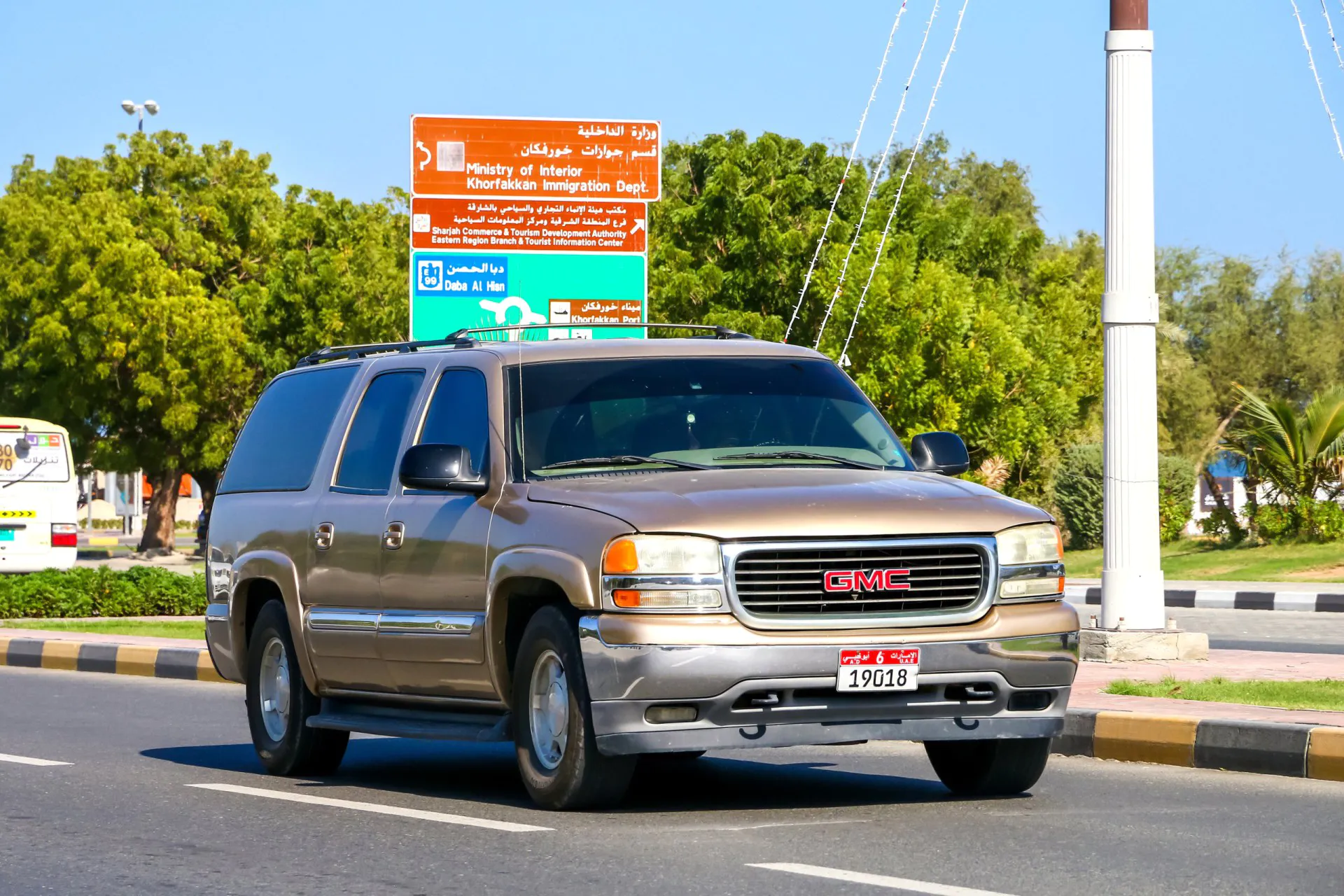
FIXD Reliability Score: 1-5/10
Owner Reliability Score: 5-7/10
KBB Value: $3,660-$3,973
Fuel Economy: 13-14 MPG
Average Annual Maintenance/Repair: $846-$1,393
Average Likelihood of a $500+ Repair in 2022: 67%-100%
Safety Rating: 3.0-3.5/5
We found some good things about the 2005 GMC Yukon, which are detailed earlier. However, the rest of the second-generation models we analyzed (2001-2004, 2006) are best left in someone else’s hands. If there are Yukons to avoid like the plague, these are the ones.
We’re not picking on these model years solely because of age or mileage (190,000 miles on average); it’s the data that says to shop elsewhere (although age and mileage do affect reliability).
Within the last year, more than 18% of the 2003, 2004, and 2006 Yukons in our survey experienced an expensive engine repair. It’s somewhat less bad for the 2002 Yukon with 9% visiting the repair shop for the same reason.
However, don’t think the 2001 model year is any better. One-third of these Yukons in the survey required transmission repairs costing $500 or more. And 11 recalls make the 2001 model year among the most recalled Yukons.
All these troubles are confirmed by very low FIXD Reliability Scores. The 2001 and 2006 Yukon have a 1 (out of 10) ranking, while the 2003 and 2004 model years aren’t much better with a score of 2.
Further, the 2001 and 2002 editions rank poorly in NHTSA crash tests, with both rating a 3.0 (out of 5.0). The 2003 Yukon notches up to a 3.3, but that’s still well below the competition.
There are a significant number of recalls for some of the Yukons in this grouping. In particular, the 2001 model has 11 recalls and 2003 has 8 recalls. The 2003 and 2004 models are slightly better with 6 recalls each, but that’s still far from ideal. There are 4 recalls for the 2006 Yukon.
If you have to buy a bottom-dollar Yukon, look for the 2005 model year. Or scrape up some extra funds for the 2009 edition.
FAQs
What years of the GMC Yukon have engine and/or transmission problems?
2003, 2004, 2006, 2008, and 2010-2013 are the Yukon model years with the greatest chance of needing engine repairs costing $500 or more. In addition, the 2001, 2006, and 2012 Yukons have an increased likelihood of needing costly transmission repairs.
What is considered high mileage for a GMC Yukon?
Determining when a GMC Yukon crosses the high-mileage threshold is challenging to pin down.
According to owner surveys, the average GMC Yukon from the 2001-2021 model years has 150,000 miles. Much of this longevity is due to regular maintenance, careful driving, and probably a lot of highway travel. Based on the survey data, we’d use this average as the dividing mark between a standard mileage and a high-mileage Yukon.
However, there are undoubtedly 200,000-mile Yukons out there that are ready for more years of service. At the same time, there are likely some 100,000-mile Yukons that won’t be around for much longer. A qualified mechanic is the best determiner of what makes for a high-mileage vehicle.
Data shows that the Yukons are readily able to exceed 200,000 miles. In fact, the 2001-2006 Yukons have an average of 208,000 miles, with some individual model years going much further. For instance, the mileage for a surveyed 2002 Yukon averages an astounding 267,000 miles. Yet, the data also reveals that owning one of these high-mileage Yukons comes with its share of check engine lights and repairs.
If the idea is to drive a Yukon to 200,000 miles or more, at least start with the 2013-2014 Yukon. For even greater longevity, choose a 2017-2020 Yukon, which has an average of 61,000 miles (based on the survey). All of these Yukon are on the best years list.
What other vehicles should I consider?
The logical alternative to the GMC Yukon is the almost-identical Chevrolet Tahoe. If needs require a different size GMC SUV, the buyers should consider the even larger GMC Yukon XL. Heading in the opposite direction, GMC offers the three-row (but smaller) Acadia and the two-row Terrain.
Options outside of General Motors include the Ford Expedition, Jeep Wagoneer, Toyota Sequoia, and Nissan Armada.
What owners of the GMC Yukon like to use their cars for:
| Frequent Use Categories: | How Useful? (Out of 5 Stars) |
| Lots of Driving (travel/long commute) | **** |
| Family Vehicle | *** |
| Sport/Fast Driving | ** |
| Hauling/Towing | * |
| Office on Wheels | * |
| Luxurious Driving | * |
| Outdoor/Off-Road | * |
A Note About Data and Information Sources
This article has many details about GMC Yukon reliability; here’s what we used for our assumptions and recommendations.
- FIXD Reliability Score & Data: Engine reliability information is captured via the FIXD App.
The FIXD Reliability Score is calculated using the number of DTCs per year, weighted by mileage. This is then turned into a scale of 1-10 for easy graphing.
This is an objective score.
- Owner Reliability Score & Data: This data is the result of surveying GMC Yukon owners who use FIXD.
The Owner Reliability Score comes straight from the owners of the GMC Yukon.
This is a subjective score.
To determine the Owner Reliability Score we ask each car owner:
How reliable would you say your GMC Yukon is?
a. Just point A to point B driving
b. A Daily Commuter
c. Good for a 100-mile road trip
d. Good for a 500-mile road trip
e. I could take a cross-country road trip, no problem
From here we translate their answers into the Owner Reliability Score:
a. = 2
b. = 4
c. = 6
d. = 8
e. = 10
Keep in mind owners may think their car is more or less reliable than it actually is.
One potential problem is that people often buy the same make or model they are used to when they go car shopping, just a newer year.
Ford, for instance, has a number of consumer loyalty awards for the Ford F-Series, Ford Mustang, and Ford Expedition.
Car owners may be so loyal to the make or model they currently own that they would have trouble accurately comparing their cars’ reliability to others.
It’s for this reason that we ask car owners a question that is relative to mileage rather than relative to other cars.
Still, be mindful of the accuracy of these Owner Reliability Scores; people’s perceptions and unconscious blindspots can skew data.
We suggest looking at both the FIXD Reliability Score and the Owner Reliability Score for this reason.
- KBB Value: Average private-seller valuations as supplied by Kelley Blue Book (KBB), based on a GMC Yukon with typical mileage for that respective model year.
- Fuel Economy: Mileage-per-gallon estimates according to the EPA MPG on Fueleconomy.gov
- Annual Maintenance/Repair: Upkeep expenses as reported by surveyed GMC Yukon owners
- Safety Rating: Crash test data collected and reported by NHTSA. We average all ratings for each year to come up with a simplified, average safety score. This makes it easier to look at on a graph.
References
- GMC Yukon model-specific information, edmunds.com (various dates). Retrieved May 5, 2023, from https://www.edmunds.com/
- Model-specific recall information as per the National Highway Transportation Safety Administration. Retrieved May 5, 2023, from https://www.nhtsa.gov/recalls
- GMC Limited Warranty Information. Retrieved May 5, 2023, from https://www.gmc.com/owners/warranty-protection-plans

Dave Goldberg is an automotive journalist and lifelong car fanatic. He writes for numerous enthusiast and business outlets and is an ongoing contributor to HotCars.com, one of the most popular car culture websites. When he’s not writing or driving, Dave is either under a hood or asleep. His credentials include a BA in Journalism from The George Washington University.













